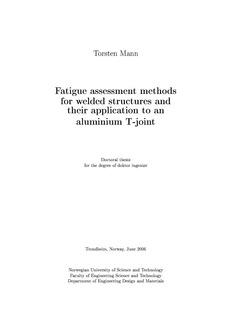| dc.contributor.author | Mann, Torsten | nb_NO |
| dc.date.accessioned | 2014-12-19T12:25:55Z | |
| dc.date.available | 2014-12-19T12:25:55Z | |
| dc.date.created | 2007-01-19 | nb_NO |
| dc.date.issued | 2006 | nb_NO |
| dc.identifier | 121818 | nb_NO |
| dc.identifier.isbn | 82-471-8019-7 | nb_NO |
| dc.identifier.uri | http://hdl.handle.net/11250/241283 | |
| dc.description.abstract | Following a short introduction, the state-of-the-art fatigue life assessment methods based on the nominal stress, the structural hot spot stress and the effective notch stress, as well as the crack propagation analysis are explained and discussed.
Thereafter, the effect of mean stress on crack propagation was investigated by exemplifying crack propagation data from different aluminium alloys. In this context, Walker's equation received wide attention. In addition, a new, simple equation to express the mean stress dependency of crack propagation data has been proposed.
In order to generate crack propagation data for the 6082-T6 aluminium alloy, investigate the behaviour of short cracks and find the mean stress dependency of crack growth in this alloy, crack propagation tests of sub-millimetre cracks subjected to different stress ratios have been carried out. The crack depth was successfully monitored on-line employing a special direct current potential drop technique. The crack propagation data generated verified the long crack propagation data given in Eurocode 9. In addition, useful experience was gained to improve future tests. Some evidence was found of accelerated crack growth near the threshold. Based on the data obtained and literature data a Walker exponent γ= 0.78 has been calculated for the aluminium alloy 6082-T6.
The fatigue life of welded aluminium T-joints has been estimated using the approaches introduced in Chapter 2. The results have been compared with experimental data from T-joints subjected to 4-point bending. In addition, a series of T-joints subjected to transverse bending has been fatigue tested and the results have been compared with predictions using the same fatigue life assessment methods.
The nominal stress gave a conservative prediction in case of the 4-point bending loading. Since no applicable detail category for the transverse bending load case exists, a suitable detail category has been suggested.
The structural hot spot stress approach resulted in conservative predictions (factor 4-10 in life) for both load cases.
The predictions from the effective notch stress approach are in excellent agreement with the experimental results, where the method using a 1 mm weld toe radius gave the best results. It has been shown that the method can be successfully applied to joints with wall thicknesses down to 3 mm.
The fatigue life predicted with the crack propagation approaches is in excellent agreement with the experimental results from the 4-point bending load when the Mk factor was used. Applying the local stress distribution, the predictions are conservative for both load cases.
The slopes of all predicted S-N curves, especially from the stress based methods, are steeper than the experimental curves. | nb_NO |
| dc.language | eng | nb_NO |
| dc.publisher | Fakultet for ingeniørvitenskap og teknologi | nb_NO |
| dc.relation.ispartofseries | Doktoravhandlinger ved NTNU, 1503-8181; 2006:129 | nb_NO |
| dc.subject | Sveisekonstruksjoner | no_NO |
| dc.subject | Aluminium | no_NO |
| dc.subject | utmatting | no_NO |
| dc.subject | sprekkvekst | no_NO |
| dc.title | Fatigue assessment methods for welded structures and their application to an aluminium T-joint | nb_NO |
| dc.type | Doctoral thesis | nb_NO |
| dc.source.pagenumber | 138 | nb_NO |
| dc.contributor.department | Norges teknisk-naturvitenskapelige universitet, Fakultet for ingeniørvitenskap og teknologi, Institutt for produktutvikling og materialer | nb_NO |
| dc.description.degree | dr.ing. | nb_NO |
| dc.description.degree | dr.ing. | en_GB |
